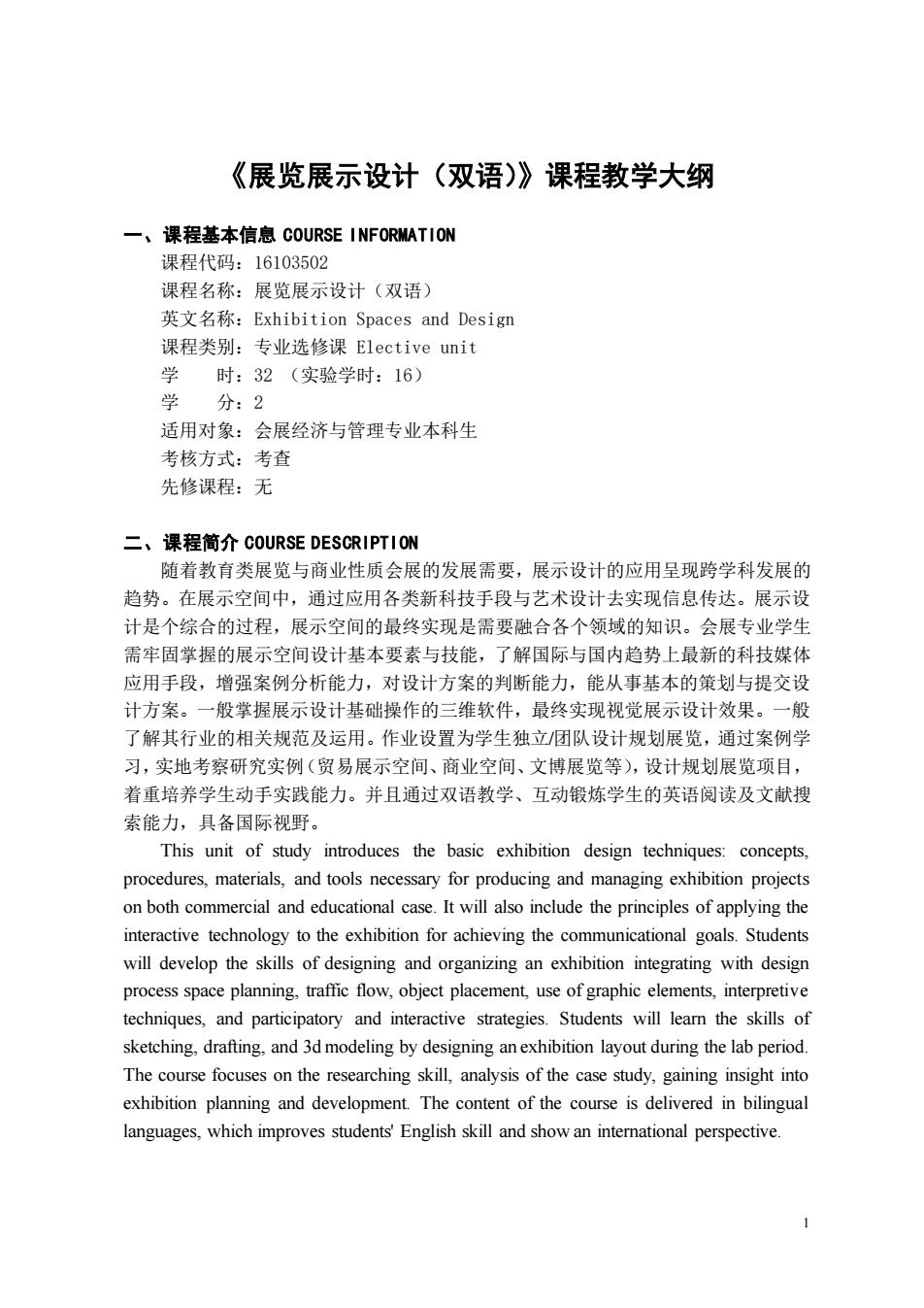
《展览展示设计(双语)》课程教学大纲 一、课程基本信息COURSE INFORMATION 课程代码:16103502 课程名称:展览展示设计(双语) 英文名称:Exhibition Spaces and Design 课程类别:专业选修课Elective unit 时:32(实验学时:16》 学 分:2 适用对象:会展经济与管理专业本科生 老核方式:老杳 先修课程:无 二、课程简介COURSE DESCRIPTION 随着教育类展览与商业性质会展的发展需要,展示设计的应用呈现跨学科发展的 趋势。在展示空间中,通过应用各类新科技手段与艺术设计去实现信息传达。展示设 计是个综合的过程,展示空间的最终实现是需要融合各个领域的知识。会展专业学生 需牢固掌握的展示空间设计基本要素与技能,了解国际与国内趋势上最新的科技媒体 应用手段,增强案例分析能力,对设计方案的判断能力,能从事基本的策划与提交设 计方案。一般掌握展示设计基础操作的三维软件,最终实现视觉展示设计效果。一般 了解其行业的相关规范及运用。作业设置为学生独立团队设计规划展览,通过案例学 习,实地考察研究实例(贸易展示空间、商业空间、文博展览等),设计规划展览项目, 着重培养学生动手实践能力。并且通过双语教学、互动锻炼学生的英语阅读及文献搜 索能力,具备国际视野。 This unit of study introduces the basic exhibition design techniques:concepts, procedures,materials,and tools necessary for producing and managing exhibition projects on both commercial and educational case.It will also include the principles of applying the interactive technology to the exhibition for achieving the communicational goals.Students will develop the skills of designing and organizing an exhibition integrating with design process space planning,traffic flow,object placement,use of graphic elements,interpretive techniques,and participatory and interactive strategies.Students will learn the skills of sketching,drafting.and 3d modeling by designing anexhibition layout during the lab period. The course focuses on the researching skill,analysis of the case study,gaining insight into exhibition planning and development.The content of the course is delivered in bilingual languages,which improves students'English skill and show an international perspective
1 《展览展示设计(双语)》课程教学大纲 一、课程基本信息 COURSE INFORMATION 课程代码:16103502 课程名称:展览展示设计(双语) 英文名称:Exhibition Spaces and Design 课程类别:专业选修课 Elective unit 学 时:32 (实验学时:16) 学 分:2 适用对象:会展经济与管理专业本科生 考核方式:考查 先修课程:无 二、课程简介 COURSE DESCRIPTION 随着教育类展览与商业性质会展的发展需要,展示设计的应用呈现跨学科发展的 趋势。在展示空间中,通过应用各类新科技手段与艺术设计去实现信息传达。展示设 计是个综合的过程,展示空间的最终实现是需要融合各个领域的知识。会展专业学生 需牢固掌握的展示空间设计基本要素与技能,了解国际与国内趋势上最新的科技媒体 应用手段,增强案例分析能力,对设计方案的判断能力,能从事基本的策划与提交设 计方案。一般掌握展示设计基础操作的三维软件,最终实现视觉展示设计效果。一般 了解其行业的相关规范及运用。作业设置为学生独立/团队设计规划展览,通过案例学 习,实地考察研究实例(贸易展示空间、商业空间、文博展览等),设计规划展览项目, 着重培养学生动手实践能力。并且通过双语教学、互动锻炼学生的英语阅读及文献搜 索能力,具备国际视野。 This unit of study introduces the basic exhibition design techniques: concepts, procedures, materials, and tools necessary for producing and managing exhibition projects on both commercial and educational case. It will also include the principles of applying the interactive technology to the exhibition for achieving the communicational goals. Students will develop the skills of designing and organizing an exhibition integrating with design process space planning, traffic flow, object placement, use of graphic elements, interpretive techniques, and participatory and interactive strategies. Students will learn the skills of sketching, drafting, and 3d modeling by designing an exhibition layout during the lab period. The course focuses on the researching skill, analysis of the case study, gaining insight into exhibition planning and development. The content of the course is delivered in bilingual languages, which improves students' English skill and show an international perspective

三、课程性质与教学目的PROGRAM MISSION&LEARNING OUTCOMES 《展览展示设计》为会展经济与管理专业本科生的选修课程。 1)介绍展览展示设计概念,掌握设计流程与设计项目管理统筹。 2)理解展示设计与观众的沟通手段与信息传达的方式,了解色彩与信息设计对 展示的影响。 3)讲行室内外场地分析,有效规划据示库间 4)学习展示空间结构与人体工学相关的内容,设计空间布局观众的影响。 5)了解各类高新科技在展示设计中的应用与效用,关注本地创新展示项目,侧 重交互技术与科技发展。 6)通过创意思维练习,掌握设计方法。 )通过案例学习及实地调研,掌握对展示设计空间分析能力。 8)并结合思政内容,强调社会主义核心价值观,弘扬习近平新时代中国特色社 会主义思想。推广“科技兴国”战略,增强学生对信息科技的兴趣。并且从案例中突 出我国科技在展示设计中的应用与创新。 9)学习使用电脑三维绘图软件进行展示设计创意,掌握三维设计建模原理,理解 三维设计流程,掌握三维设计软件(Sketchup)的基本操作,根据各类展览设计需求进行 软件应用。 10)通过增加外语授课内容,提升学生英语阅读及理解能力。 Elective course and objectives: 1.Provide students with an understanding of basic exhibition design techniques and the procedures of planning an exhibition; 2.Introduce students to a range of skills for communication,designing.planning.and evaluating an exhibition design theory and information design 3.Site analysis and planning the exhibition space; 4.Includes the knowledge of organizing the space,proportioning system, 5.Student will understand function ofinteractive technology applied to exhibition,pay attention to local innovation display projects,focusing on interactive technology and technological development: 6.Learn design methods through creative thinking exercises 7.Through case study and field investigation,master the ability to analyze the display design space 8.Combined with ideological and political content,emphasizing the core values of socialism,and promoting XiJinping's newera ofsocialism with Chinese characteristics Promote the strategy of"rejuvenating the country through science and technology"to
2 三、课程性质与教学目的 PROGRAM MISSION & LEARNING OUTCOMES 《展览展示设计》为会展经济与管理专业本科生的选修课程。 1) 介绍展览展示设计概念,掌握设计流程与设计项目管理统筹。 2) 理解展示设计与观众的沟通手段与信息传达的方式,了解色彩与信息设计对 展示的影响。 3) 进行室内外场地分析,有效规划展示空间。 4) 学习展示空间结构与人体工学相关的内容,设计空间布局观众的影响。 5) 了解各类高新科技在展示设计中的应用与效用,关注本地创新展示项目,侧 重交互技术与科技发展。 6) 通过创意思维练习,掌握设计方法。 7) 通过案例学习及实地调研,掌握对展示设计空间分析能力。 8) 并结合思政内容,强调社会主义核心价值观,弘扬习近平新时代中国特色社 会主义思想。推广“科技兴国”战略,增强学生对信息科技的兴趣。并且从案例中突 出我国科技在展示设计中的应用与创新。 9) 学习使用电脑三维绘图软件进行展示设计创意,掌握三维设计建模原理,理解 三维设计流程,掌握三维设计软件(Sketchup)的基本操作,根据各类展览设计需求进行 软件应用。 10) 通过增加外语授课内容,提升学生英语阅读及理解能力。 Elective course and objectives: 1. Provide students with an understanding of basic exhibition design techniques and the procedures of planning an exhibition; 2. Introduce students to a range of skills for communication, designing, planning, and evaluating an exhibition design project; color theory and information design 3. Site analysis and planning the exhibition space; 4. Includes the knowledge of organizing the space, proportioning system; 5. Student will understand function of interactive technology applied to exhibition, pay attention to local innovation display projects, focusing on interactive technology and technological development; 6. Learn design methods through creative thinking exercises; 7. Through case study and field investigation, master the ability to analyze the display design space. 8. Combined with ideological and political content, emphasizing the core values of socialism, and promoting Xi Jinping's new era of socialism with Chinese characteristics. Promote the strategy of "rejuvenating the country through science and technology" to

enhance students'interest in information technology.Though case studies,highlight the application and innovation of technology application in display design. 9.Give the student an understanding of the basic concepts of modeling and presentation so that they will develop skills in creating and using 3D modeling software(Sketchup)for visualizing different kinds of exhibition design 10.Increasing the course's content with English translation,Improve students English reading skill. 四、教学内容及要求COURSE CONTENT&COURSE OUTL INE 模块一展览展示设计简介 Section One Introducing exhibition space and exhibition design (一)目的与要求Course outline 1。了醒课程简介,里程讲度,作业要求,参老资料 2.通过启蒙案例,初步了解各类展示空间设计; 3.介绍课程所应用的三维建模软件Sketchup 4.弘扬“科技兴国”战略,增强学生对信息科技的兴趣,了解掌握技术对就业帮 助。 1.Understand the course outline,schedule of weekly class,notices,reading lists and setting of assignments. 2.Leamn different types of exhibition space through case studies. 3.Introducing 3D modeling software application in the Lab section,which refer to Sketchup. 4.Promote the strategy of "rejuvenating the country through science and technology"to enhance students'interest in information technology Understand software manipulation will be benefit to the employment. (二)教学内容Course content l.主要内容Main content 。 课程简介,课程进度,作业要求,参考资料:展览设计案例: 维建模软件Sketchup介绍: 普及就业技能需求,介绍掌握技术与提升动手能力的重要性,宜传“科技 兴国”战略。 Course outline,schedule of weekly class,notices and setting ofassignments; Case studies of exhibition design: Introducing 3D modeling software Sketchup: The demand of employment skills include software operation and practical 3
3 enhance students' interest in information technology. Though case studies, highlight the application and innovation of technology application in display design. 9. Give the student an understanding of the basic concepts of modeling and presentation so that they will develop skills in creating and using 3D modeling software (Sketchup) for visualizing different kinds of exhibition design. 10. Increasing the course’s content with English translation, Improve students' English reading skill. 四、教学内容及要求 COURSE CONTENT & COURSE OUTLINE 模块一 展览展示设计简介 Section One Introducing exhibition space and exhibition design (一)目的与要求 Course outline 1.了解课程简介,课程进度,作业要求,参考资料; 2.通过启蒙案例,初步了解各类展示空间设计; 3.介绍课程所应用的三维建模软件 Sketchup; 4. 弘扬“科技兴国”战略,增强学生对信息科技的兴趣,了解掌握技术对就业帮 助。 1.Understand the course outline, schedule of weekly class, notices, reading lists and setting of assignments. 2.Learn different types of exhibition space through case studies. 3.Introducing 3D modeling software application in the Lab section, which refer to Sketchup. 4. Promote the strategy of "rejuvenating the country through science and technology" to enhance students' interest in information technology. Understand software manipulation will be benefit to the employment. (二)教学内容 Course content 1.主要内容 Main content - 课程简介,课程进度,作业要求,参考资料;展览设计案例; - 三维建模软件 Sketchup 介绍; - 普及就业技能需求,介绍掌握技术与提升动手能力的重要性,宣传“科技 兴国”战略。 - Course outline, schedule of weekly class, notices and setting of assignments; - Case studies of exhibition design; - Introducing 3D modeling software Sketchup; - The demand of employment skills include software operation and practical
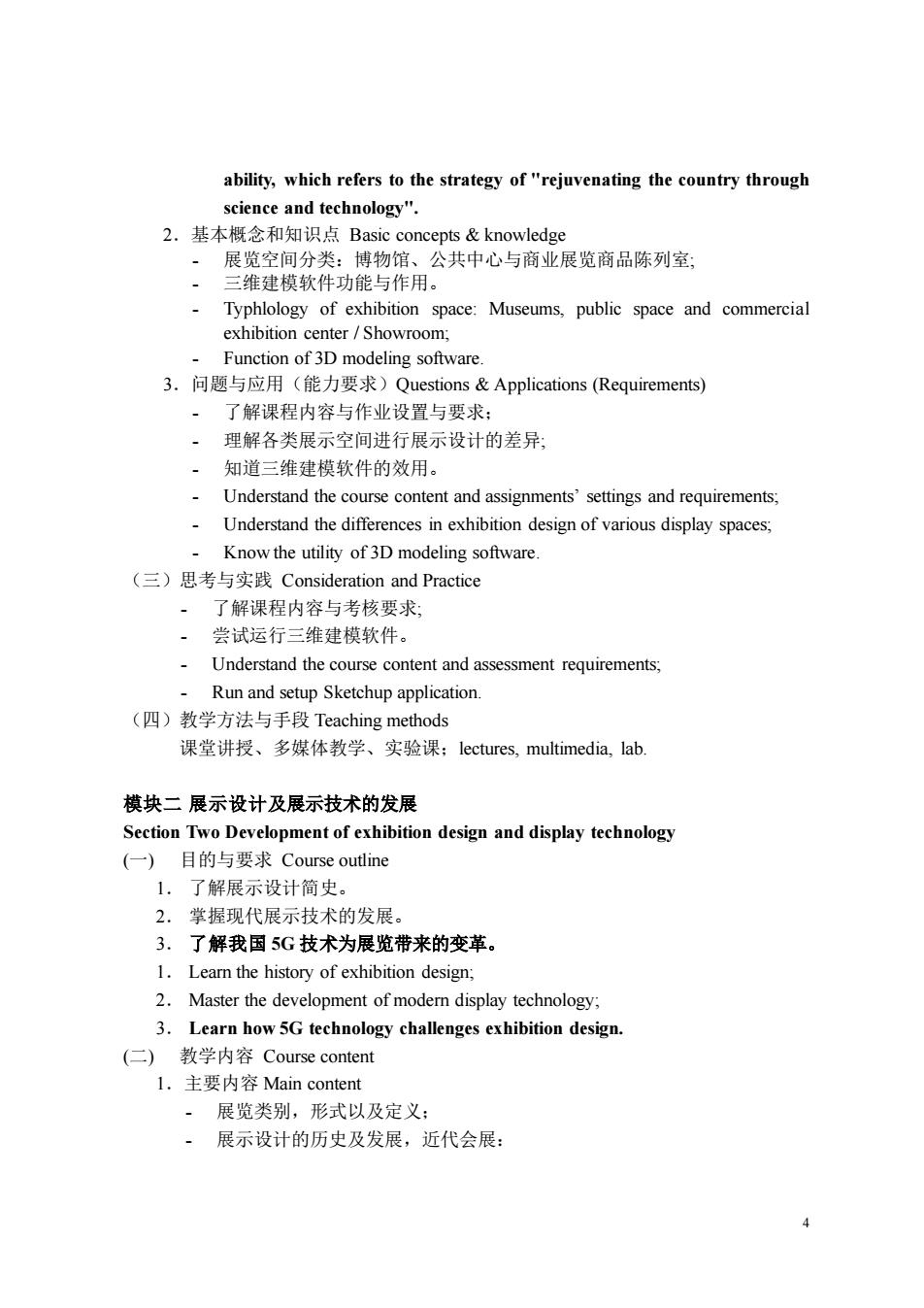
ability,which refers to the strategy of"rejuvenating the country through science and technology". 2.基本概念和知识点Basic concepts&knowledge 展览空间分类:博物馆、公共中心与商业展览商品陈列室 三维建模软件功能与作用。 Typhlology of exhibition space:Museums,public space and commercial exhibition center Showroom: -Function of 3D modeling software. 3.问题与应用(能力要求)Questions&Applications(Requirements) 了解课程内容与作业设置与要求: 理解各类展示空间进行展示设计的差异 知道三维律模软件的效用。 Understand the course content and assignments'settings and requirements, Understand the differences in exhibition design of various display spaces. Know the utility of 3D modeling software. (三)思考与实践Consideration and Practice 了解课程内容与考核要求 尝试运行三维建模软件。 Understand the course content and assessment requirements: Run and setup Sketchup application (四)教学方法与手段Teaching methods 课堂讲授、多媒体教学、实验课:lectures,multimedia,lab, 模块二展示设计及展示技术的发展 Section Two Development of exhibition design and display technology (一)目的与要求Course outline 1.了解展示设计简史。 2. 掌握现代展示技术的发展 3.了解我国5G技术为展览带来的变革。 1.Leam the history of exhibition design 2.Master the development of modern display technology 3.Learn how 5G technology challenges exhibition design. (二)教学内容Course content .主要内容Main content -展览类别,形式以及定义: 展示设计的历史及发展,近代会展: 4
4 ability, which refers to the strategy of "rejuvenating the country through science and technology". 2.基本概念和知识点 Basic concepts & knowledge - 展览空间分类:博物馆、公共中心与商业展览商品陈列室; - 三维建模软件功能与作用。 - Typhlology of exhibition space: Museums, public space and commercial exhibition center / Showroom; - Function of 3D modeling software. 3.问题与应用(能力要求)Questions & Applications (Requirements) - 了解课程内容与作业设置与要求; - 理解各类展示空间进行展示设计的差异; - 知道三维建模软件的效用。 - Understand the course content and assignments’ settings and requirements; - Understand the differences in exhibition design of various display spaces; - Know the utility of 3D modeling software. (三)思考与实践 Consideration and Practice - 了解课程内容与考核要求; - 尝试运行三维建模软件。 - Understand the course content and assessment requirements; - Run and setup Sketchup application. (四)教学方法与手段 Teaching methods 课堂讲授、多媒体教学、实验课;lectures, multimedia, lab. 模块二 展示设计及展示技术的发展 Section Two Development of exhibition design and display technology (一) 目的与要求 Course outline 1. 了解展示设计简史。 2. 掌握现代展示技术的发展。 3. 了解我国 5G 技术为展览带来的变革。 1. Learn the history of exhibition design; 2. Master the development of modern display technology; 3. Learn how 5G technology challenges exhibition design. (二) 教学内容 Course content 1.主要内容 Main content - 展览类别,形式以及定义; - 展示设计的历史及发展,近代会展:
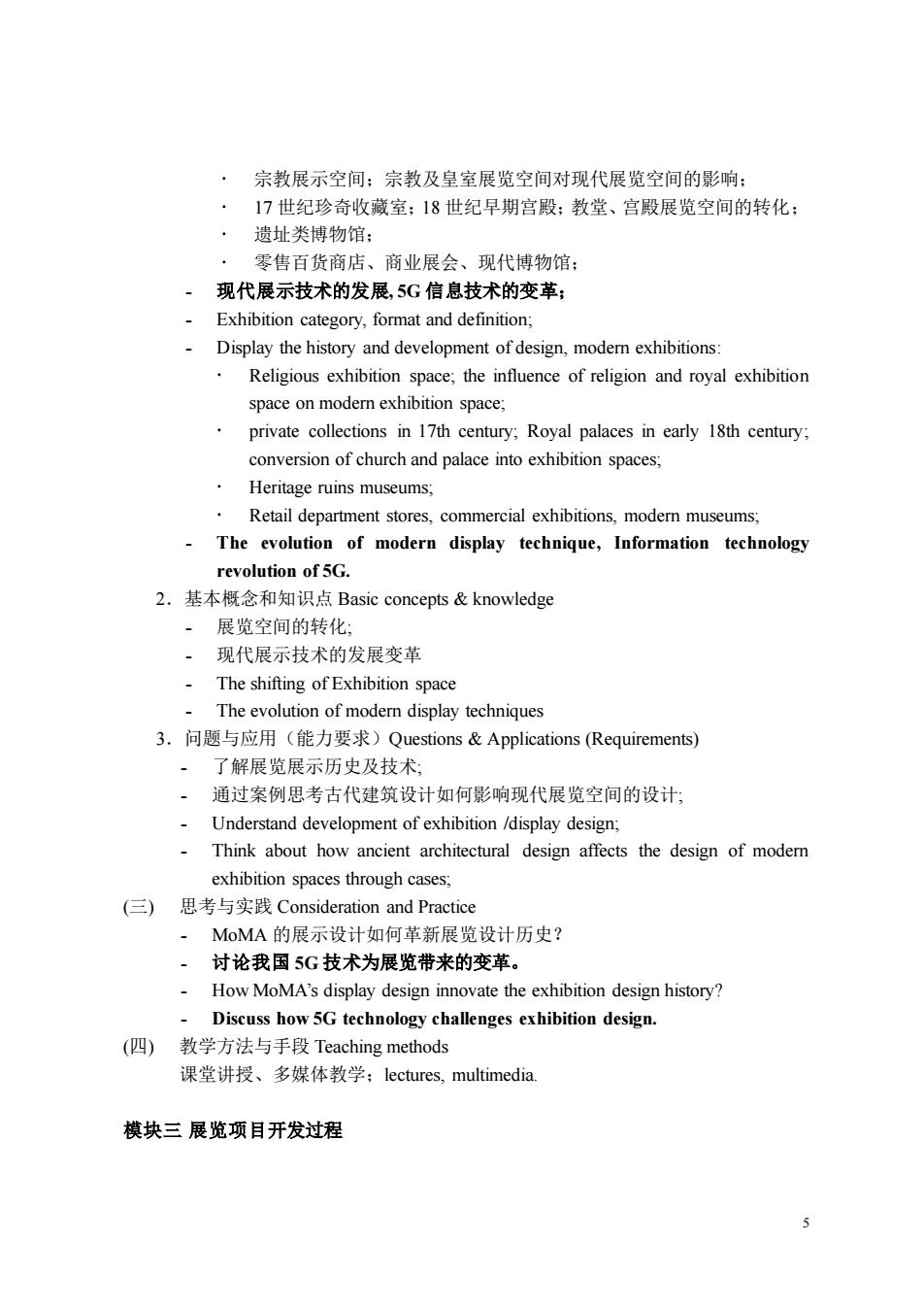
宗教展示空间:宗教及皇室展览空间对现代展览空间的影响: 17世纪珍奇收藏室:18世纪早期宫殿:教堂、宫殿展览空间的转化: 遗址类博物馆: 零售百货商店、商业展会、现代博物馆 现代展示技术的发展,5G信息技术的变革: Exhibition category,format and definition; Display the history and development of design.modem exhibitions: Religious exhibition space;the influence of religion and royal exhibition space on modern exhibition space. private collections in 17th century;Royal palaces in early 18th century; conversion of church and palace into exhibition spaces. Heritage ruins museums: .Retail department stores,commercial exhibitions,moder museums The evolution of modern display technique,Information technology revolution of 5G. 2.基本概念和知识点Basic concepts&knowledge 展览空间的转化: 现代展示技术的发展变革 The shifting of Exhibition space The evolution of modern display techniques 3.问题与应用(能力要求)Questions&Applications(Requirements) 了解展览展示历史及技术, 通过案例思考古代建筑设计如何影响现代展览空间的设计 Understand development of exhibition /display design; Think about how ancient architectural design affects the design of moder exhibition spaces through cases: (三) 思考与实践Consideration and Practice ·MoMA的展示设计如何革新展览设计历史? 讨论我国5G技术为展览带来的变革 How MoMA's display design innovate the exhibition design history? Discuss how 5G technology challenges exhibition design. (四)教学方法与手段Teaching methods 课堂讲授、多媒体教学;lectures,multimedia 模块三展览项目开发过程
5 宗教展示空间;宗教及皇室展览空间对现代展览空间的影响; 17 世纪珍奇收藏室;18 世纪早期宫殿;教堂、宫殿展览空间的转化; 遗址类博物馆; 零售百货商店、商业展会、现代博物馆; - 现代展示技术的发展, 5G 信息技术的变革; - Exhibition category, format and definition; - Display the history and development of design, modern exhibitions: Religious exhibition space; the influence of religion and royal exhibition space on modern exhibition space; private collections in 17th century; Royal palaces in early 18th century; conversion of church and palace into exhibition spaces; Heritage ruins museums; Retail department stores, commercial exhibitions, modern museums; - The evolution of modern display technique, Information technology revolution of 5G. 2.基本概念和知识点 Basic concepts & knowledge - 展览空间的转化; - 现代展示技术的发展变革 - The shifting of Exhibition space - The evolution of modern display techniques 3.问题与应用(能力要求)Questions & Applications (Requirements) - 了解展览展示历史及技术; - 通过案例思考古代建筑设计如何影响现代展览空间的设计; - Understand development of exhibition /display design; - Think about how ancient architectural design affects the design of modern exhibition spaces through cases; (三) 思考与实践 Consideration and Practice - MoMA 的展示设计如何革新展览设计历史? - 讨论我国 5G 技术为展览带来的变革。 - How MoMA’s display design innovate the exhibition design history? - Discuss how 5G technology challenges exhibition design. (四) 教学方法与手段 Teaching methods 课堂讲授、多媒体教学;lectures, multimedia. 模块三 展览项目开发过程

Section Three Exhibition design process (一) 目的与要求Course outline 1.了解展览项目开发过程及设计流程。 2.掌握设计说明的书写方法 3.理解运用展示空间陈述故事的手段 1. Understand the exhibition project development process and design process 2 Master the writing of design brief. 3.Understand the use of display space to tell stories. (二)教学内容Course content l.主要内容Main content 展监项目开发讨语 展览展示设计流程 设计理念,设计策划方法,书写设计说明 分析设计说明,案例讲解: How to Plan and Design an Exhibition Exhibition design process, Design concept,design planning methods and design brief. Analyzing the Design brief,case study. 2.基本概念和知识点Basic concepts&knowledge 展示设计设计流程: 设计说明: 、 空间叙事,品牌与空间: Exhibition design process 、 design brief. Space narrative,branding space; 3.问题与应用(能力要求)Questions&Applications(Requirements) 了解展览设计项目开发及工作流程 调研作业与期末考核展览设计项目作为展览设计项目开发的环节与最终展 示效果 Understand how to plan an exhibition and work in the project team, Research assignments and final assessment of exhibition design projects as the link of exhibition design project development and the final display effect. (E)思考与实践Consideration and Practice 。通过案例分析,理解设计说明的作用: Through case analysis.understand the role of design brief: 6
6 Section Three Exhibition design process (一) 目的与要求 Course outline 1. 了解展览项目开发过程及设计流程。 2. 掌握设计说明的书写方法。 3. 理解运用展示空间陈述故事的手段。 1. Understand the exhibition project development process and design process. 2. Master the writing of design brief. 3. Understand the use of display space to tell stories. (二) 教学内容 Course content 1.主要内容 Main content - 展览项目开发过程; - 展览展示设计流程; - 设计理念,设计策划方法,书写设计说明; - 分析设计说明,案例讲解; - How to Plan and Design an Exhibition; - Exhibition design process; - Design concept; design planning methods and design brief; - Analyzing the Design brief, case study. 2.基本概念和知识点 Basic concepts & knowledge - 展示设计设计流程; - 设计说明; - 空间叙事,品牌与空间; - Exhibition design process; - design brief; - Space narrative, branding space; 3.问题与应用(能力要求)Questions & Applications (Requirements) - 了解展览设计项目开发及工作流程; - 调研作业与期末考核展览设计项目作为展览设计项目开发的环节与最终展 示效果; - Understand how to plan an exhibition and work in the project team; - Research assignments and final assessment of exhibition design projects as the link of exhibition design project development and the final display effect; (三) 思考与实践 Consideration and Practice - 通过案例分析,理解设计说明的作用; - Through case analysis, understand the role of design brief;
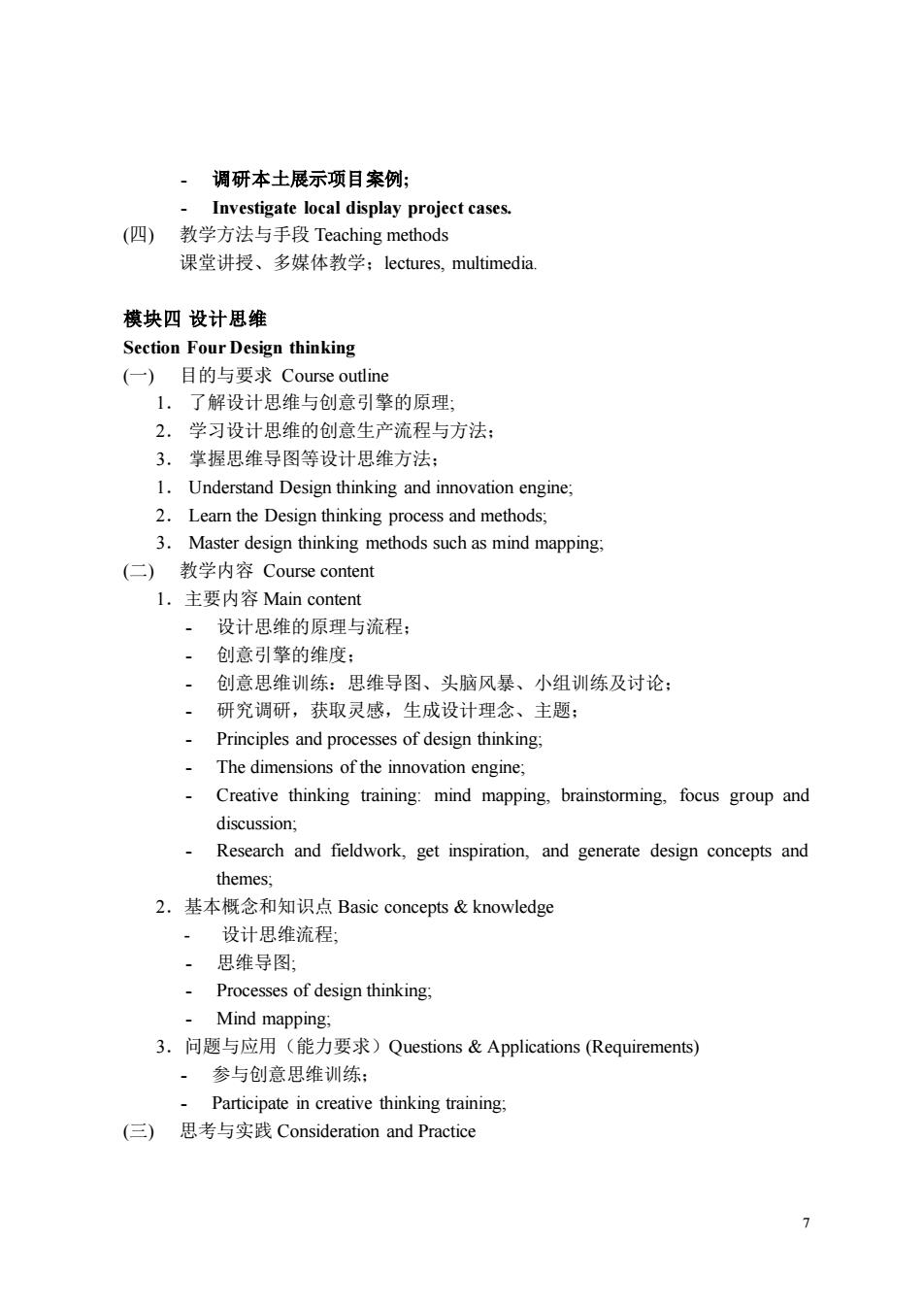
调研本土展示项目案例: Investigate local display project cases. (四)教学方法与手段Teaching methods 课堂讲授、多媒体教学:lectures,multimedia 模块四设计思维 Section Four Design thinking (一) 目的与要求Course outline 1.了解设计思维与创意引擎的原理: 2.学习设计思维的创意生产流程与方法: 3.掌握思维导图等设计思维方法: 1.Understand Design thinking and innovation engine; 2.Leamn the Design thinking process and methods, 3.Master design thinking methods such as mind mapping; (仁)教学内容Course content 1.主要内容Main content 设计思维的原理与流程: 、 创意引整的维度: 创意思维训练:思维导图、头脑风暴、小组训练及讨论: 研究调研,获取灵感,生成设计理念、主题: Principles and processes of design thinking: The dimensions of the innovation engine; Creative thinking training:mind mapping,brainstorming.focus group and discussion Research and fieldwork,get inspiration,and generate design concepts and themes 2.基本概念和知识点Basic concepts&knowledge 设计思维流程 思维导图: Processes of design thinking. Mind mapping. 3.问题与应用(能力要求)Questions&Applications(Requirements) ·参与创意思维训练: Participate in creative thinking training (三)思考与实践Consideration and Practice
7 - 调研本土展示项目案例; - Investigate local display project cases. (四) 教学方法与手段 Teaching methods 课堂讲授、多媒体教学;lectures, multimedia. 模块四 设计思维 Section Four Design thinking (一) 目的与要求 Course outline 1. 了解设计思维与创意引擎的原理; 2. 学习设计思维的创意生产流程与方法; 3. 掌握思维导图等设计思维方法; 1. Understand Design thinking and innovation engine; 2. Learn the Design thinking process and methods; 3. Master design thinking methods such as mind mapping; (二) 教学内容 Course content 1.主要内容 Main content - 设计思维的原理与流程; - 创意引擎的维度; - 创意思维训练:思维导图、头脑风暴、小组训练及讨论; - 研究调研,获取灵感,生成设计理念、主题; - Principles and processes of design thinking; - The dimensions of the innovation engine; - Creative thinking training: mind mapping, brainstorming, focus group and discussion; - Research and fieldwork, get inspiration, and generate design concepts and themes; 2.基本概念和知识点 Basic concepts & knowledge - 设计思维流程; - 思维导图; - Processes of design thinking; - Mind mapping; 3.问题与应用(能力要求)Questions & Applications (Requirements) - 参与创意思维训练; - Participate in creative thinking training; (三) 思考与实践 Consideration and Practice

绘制思维导图练习: Practice and draw a mind map; (四)教学方法与手段Teachingmethods 课堂讲授、多媒体教学、课堂讨论:lectures,multimedia,.discussion. 模块五展示设计的策略 Section Five Exhibition design strategy (一) 目的与要求Course outline 1.了解展示策略 2.学习展品分类 3掌据展监线路设计 1.Understand exhibition design strategy. 2.learn Categories of exhibits; 3.Master to design visiting route (二)教学内容Course content 1. 主要内容Main content 展览构思与展示策略叙事空间与展览主题、概念: 展品分类架构,展览线路设计: 展览空间寻路系统设计,路标指示、观众引导、位置标记: 展览空间标识系统与品牌空间: 观众体验的重要性: Display strategy.use of narrative space.themes and concepts. Categories of exhibits,design visiting route; way finding system in exhibition design,audience guidance.location markings: signs design and branding space The importance of audience experience,case analysis and discussion. 2. 基本概念和知识点Basic concepts&knowledge 展示策略 展品分类 观众参观线路设计 Exhibition design strategy Categories of exhibits Visiting route 3.问题与应用(能力要求)Questions&Applications(Requirements)) 分析案例,关联期末设计项目:
8 绘制思维导图练习; Practice and draw a mind map; (四) 教学方法与手段 Teaching methods 课堂讲授、多媒体教学、课堂讨论;lectures, multimedia, discussion. 模块五 展示设计的策略 Section Five Exhibition design strategy (一) 目的与要求 Course outline 1. 了解展示策略, 2. 学习展品分类, 3. 掌握展览线路设计; 1. Understand exhibition design strategy; 2. learn Categories of exhibits; 3. Master to design visiting route; (二) 教学内容 Course content 1. 主要内容 Main content - 展览构思与展示策略,叙事空间与展览主题、概念; - 展品分类/架构,展览线路设计; - 展览空间寻路系统设计,路标指示、观众引导、位置标记; - 展览空间标识系统与品牌空间; - 观众体验的重要性; - Display strategy, use of narrative space, themes and concepts; - Categories of exhibits, design visiting route; - way finding system in exhibition design, audience guidance, location markings; - signs design and branding space; - The importance of audience experience,case analysis and discussion. 2. 基本概念和知识点 Basic concepts & knowledge - 展示策略 - 展品分类 - 观众参观线路设计 - Exhibition design strategy - Categories of exhibits - Visiting route 3. 问题与应用(能力要求)Questions & Applications (Requirements) - 分析案例,关联期末设计项目;
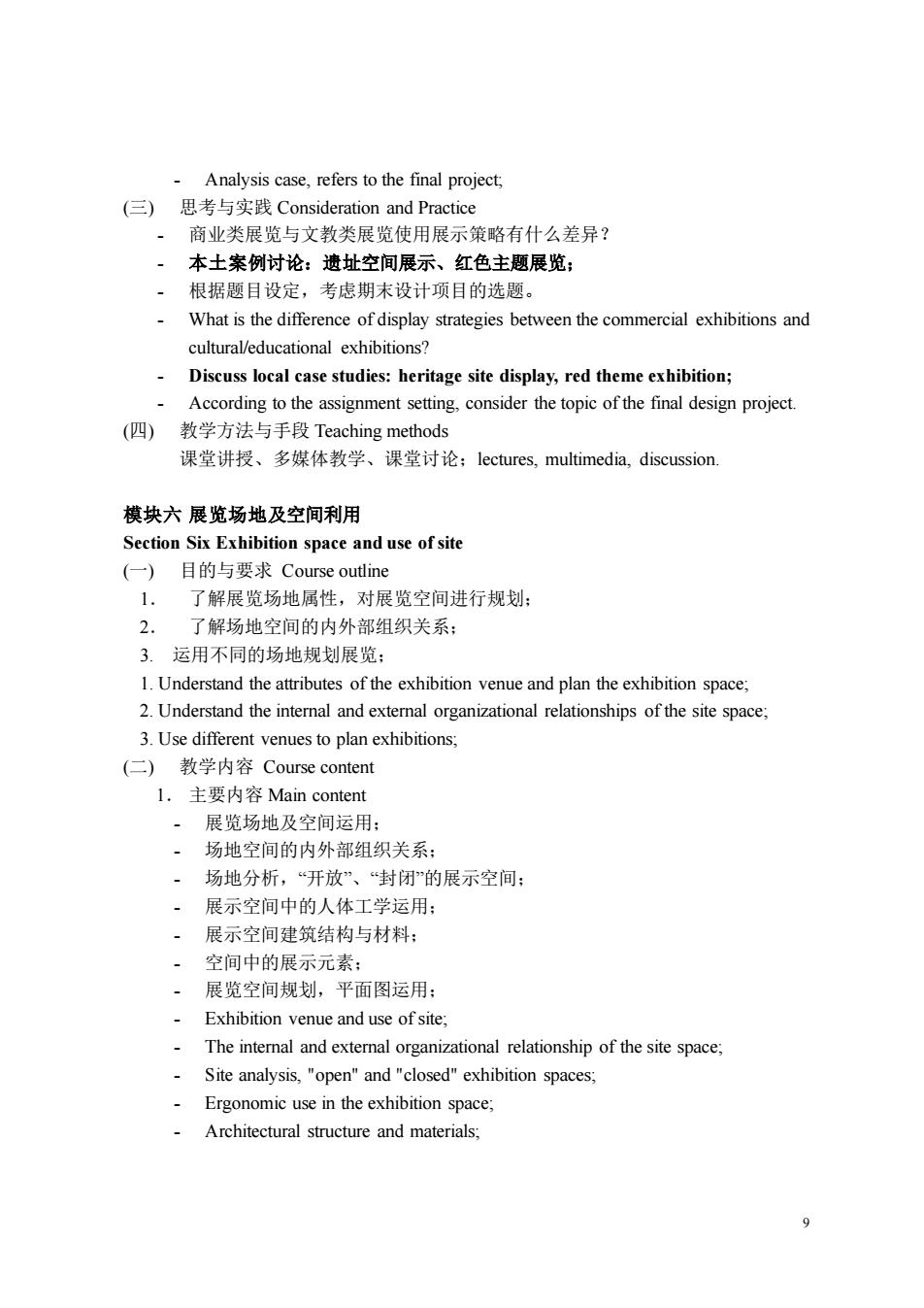
Analysis case,refers to the final project (三) 思考与实践Consideration and Practice 商业类展览与文教类展览使用展示策略有什么差异? 本土案例讨论:遗址空间展示、红色主题展览: 根据题目设定,考虑期末设计项目的选题。 What is the difference of display strategies between the commercial exhibitions and cultural/educational exhibitions? Discuss local case studies:heritage site display,red theme exhibition; According to the assignment setting,consider the topic of the final design project (四)教学方法与手段Teaching methods 课堂讲授、多媒体教学、课堂讨论;lectures,multimedia,discussion 模块六展览场地及空间利用 Section Six Exhibition space and use of site (一)目的与要求Course outline 1. 了解展览场地属性,对展览空间进行规划: 了解场地空间的内外部组织关系: 3.运用不同的场地规划展览: 1.Understand the attributes of the exhibition venue and plan the exhibition space. 2.Understand the internal and external organizational relationships of the site space, 3.Use different venues to plan exhibitions; (二)教学内容Course content 1. 主要内容Main content 展览场地及空间运用: 场地空间的内外部组织关系 场地分析,“开放”、“封闭的展示空间: 展示空间中的人体工学运用 展示空间建筑结构与材料: 空间中的展示元素: 展览空间规划,平面图运用: Exhibition venue and use of site; The interal and exteral organizational relationship of the site space 、 Site analysis,"open"and "closed"exhibition spaces; Ergonomic use in the exhibition space: Architectural structure and materials
9 - Analysis case, refers to the final project; (三) 思考与实践 Consideration and Practice - 商业类展览与文教类展览使用展示策略有什么差异? - 本土案例讨论:遗址空间展示、红色主题展览; - 根据题目设定,考虑期末设计项目的选题。 - What is the difference of display strategies between the commercial exhibitions and cultural/educational exhibitions? - Discuss local case studies: heritage site display, red theme exhibition; - According to the assignment setting, consider the topic of the final design project. (四) 教学方法与手段 Teaching methods 课堂讲授、多媒体教学、课堂讨论;lectures, multimedia, discussion. 模块六 展览场地及空间利用 Section Six Exhibition space and use of site (一) 目的与要求 Course outline 1. 了解展览场地属性,对展览空间进行规划; 2. 了解场地空间的内外部组织关系; 3. 运用不同的场地规划展览; 1. Understand the attributes of the exhibition venue and plan the exhibition space; 2. Understand the internal and external organizational relationships of the site space; 3. Use different venues to plan exhibitions; (二) 教学内容 Course content 1. 主要内容 Main content - 展览场地及空间运用; - 场地空间的内外部组织关系; - 场地分析,“开放”、“封闭”的展示空间; - 展示空间中的人体工学运用; - 展示空间建筑结构与材料; - 空间中的展示元素; - 展览空间规划,平面图运用; - Exhibition venue and use of site; - The internal and external organizational relationship of the site space; - Site analysis, "open" and "closed" exhibition spaces; - Ergonomic use in the exhibition space; - Architectural structure and materials;
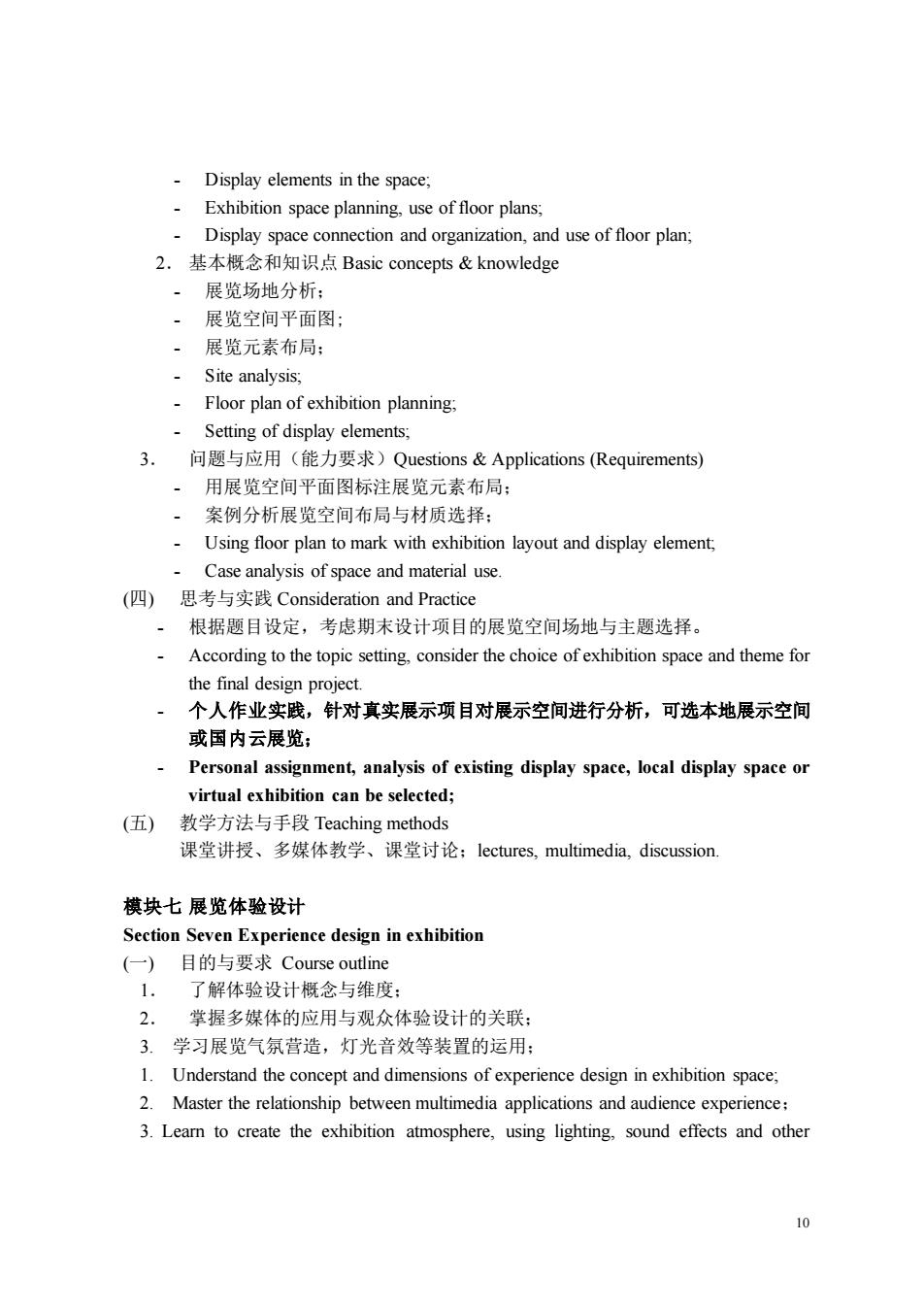
Display elements in the space; Exhibition space planning,use of floor plans; Display space connection and organization,and use of floor plan: 2.基本概念和知识点Basic concepts&knowledge -展览场地分析: 展览空间平面图: 展览元素布局: Site analysis Floor plan of exhibition planning Setting of display elements: 问题与应用(能力要求)Questions&Applications(Requirements) 用展览空间平面图标注展览元素布局: 案例分析展览空间布局与材质选择: Using floor plan to mark with exhibition layout and display element. Case analysis of space and material use (四)思考与实践Consideration and Practice 根据题目设定,考虑期末设计项目的展览空间场地与主题选择。 According to the topic setting,consider the choice of exhibition space and theme for the final design project. 个人作业实践,针对真实展示项目对展示空间进行分析,可选本地展示空间 或国内云展览: Personal assignment,analysis of existing display space,local display space or virtual exhibition can be selected; (五) 教学方法与手段Teaching methods 课堂讲授、多媒体教学、课堂讨论:lectures,,multimedia,discussion. 模块七展览体验设计 Section Seven Experience design in exhibition (一) 目的与要求Course outline 了解体验设计概念与维度: 掌握多媒体的应用与观众体验设计的关联: 3.学习展览气氛营造,灯光音效等装置的运用: 1.Understand the concept and dimensions of experience design in exhibition space; 2.Master the relationship between multimedia applications and audience experience: 3.Leamn to create the exhibition atmosphere,using lighting,sound effects and other 10
10 - Display elements in the space; - Exhibition space planning, use of floor plans; - Display space connection and organization, and use of floor plan; 2. 基本概念和知识点 Basic concepts & knowledge - 展览场地分析; - 展览空间平面图; - 展览元素布局; - Site analysis; - Floor plan of exhibition planning; - Setting of display elements; 3. 问题与应用(能力要求)Questions & Applications (Requirements) - 用展览空间平面图标注展览元素布局; - 案例分析展览空间布局与材质选择; - Using floor plan to mark with exhibition layout and display element; - Case analysis of space and material use. (四) 思考与实践 Consideration and Practice - 根据题目设定,考虑期末设计项目的展览空间场地与主题选择。 - According to the topic setting, consider the choice of exhibition space and theme for the final design project. - 个人作业实践,针对真实展示项目对展示空间进行分析,可选本地展示空间 或国内云展览; - Personal assignment, analysis of existing display space, local display space or virtual exhibition can be selected; (五) 教学方法与手段 Teaching methods 课堂讲授、多媒体教学、课堂讨论;lectures, multimedia, discussion. 模块七 展览体验设计 Section Seven Experience design in exhibition (一) 目的与要求 Course outline 1. 了解体验设计概念与维度; 2. 掌握多媒体的应用与观众体验设计的关联; 3. 学习展览气氛营造,灯光音效等装置的运用; 1. Understand the concept and dimensions of experience design in exhibition space; 2. Master the relationship between multimedia applications and audience experience; 3. Learn to create the exhibition atmosphere, using lighting, sound effects and other